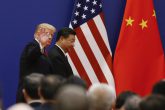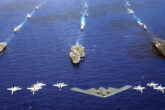October 30, 2018
Navigating a new chapter in the US-Philippines’ ‘Long Friendship’
In the Philippines, nearly a year after President Trump first sketched his Free and Open Indo-Pacific policy at the 2017 APEC CEO Summit, uncertainty about how the United States will operationalize its vision lingers. Beijing’s vaunted infusion of capital, and influence across all dimensions of Philippine society, including through its multi-billion dollar investments into key Build, Build, Build infrastructure projects, has amplified this uncertainty. Indeed, the common refrain in Manila is that while the United States remains a good friend, China will always be the Philippines’ watchful, at times menacing, northern neighbor.
As the United States operationalizes its Indo-Pacific policy, it will need to ever more conscientiously strike a balance between providing assurances of the durability of US commitment to the region and encouraging Philippine autonomy, particularly amidst Chinese incursions. The United States will also need to grapple with how best to promote its positive agenda for a rules-based order in a way that not only safeguards its own interests but also directly appeals to the aspiring middle classes of the Philippines and beyond.
The Indo-Pacific framework, at its core, underscores the shift in the global economic center of gravity and other dramatic changes that are afoot both in the Philippines and across Southeast Asia. Yet, despite the sharp contrast between today’s mercurial leaders and their predecessors, the elements of continuity in policy dwarf elements of change both in the United States and the Philippines. Across the diplomatic, economic, and security domains, the American commitment to the rule of law, freedom of navigation, sustainable economic development, and good governance both in the Philippines and the region writ large remains stronger than ever before.
Diplomatically, the United States’ Indo-Pacific policy in Southeast Asia is predicated on ASEAN centrality, as the Deputy Secretary of State recently highlighted at the ASEAN Ministerial meeting. At the same time, while ASEAN is most powerful when it speaks with a unified voice, there is also growing utility in minilateralism and more nimble, ad hoc cooperation below the ASEAN level. The Philippines’ trilateral air and maritime patrols with Indonesia and Malaysia in the Sulu and Celebes Seas offer a case in point. Moving forward, the United States should not only support ASEAN cohesion but also smaller, effective coalitions of the willing to showcase American and regional commitment to a rules-based order.
Read the full article on the Stratbase ADR Institute website.
More from CNAS
-
Why Chinese Car Investments Are a National-Security Risk
If the U.S. wants to win the competition for technology and security, it must distinguish between productive investment and Trojan horses....
By David Feith
-
Geoeconomics Summit 2025 - The Changing Dynamics of Statecraft
David Feith, adjunct senior fellow at CNAS, participated in a panel during an Institute of Geoeconomics summit in Tokyo to compare geoeconomic statecraft under the Biden and T...
By David Feith
-
Trump Heads to Asia with High-Stakes Meeting with China’s Xi on the Agenda
President Donald Trump departed Washington Friday night for Asia with trade and U.S. relations with China top of mind. He is set to hold a high-stakes sit-down with Chinese Pr...
By Jacob Stokes
-
Defense / Indo-Pacific Security
Is the U.S. Ready for War with China?U.S. military planners are caught in an impossible dilemma....
By Franz-Stefan Gady




